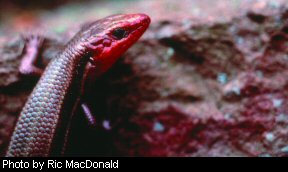

|
WILDLIFE DIVERSITY NOTEBOOK: Five-lined skink
Latin Name: Eumeces fasciatus, (from the Latin word meaning to envelop with bands). Description: This is a medium-sized, smooth, shiny-scaled lizard that may attain a total length of 8 inches. The juveniles have bright blue tails which become brown as the lizard grows older. Adults have five longitudinal yellow or white stripes on a black background, but these also become less distinct as the lizards grow older. The females may retain some traces of the stripes, but old males lose them completely, becoming uniform olive or brown on the trunk and tail. Older males develop rusty-red coloration on the head and often have entirely red heads. The belly color varies from pale cream to pale olive. Confusing Species: The five-lined skink is known locally as the blue-tailed scorpion or just as a scorpion. Because of the similarity in coloration it is easily confused with the broadhead skink, known locally as the red-headed scorpion. Telling the difference is difficult, even to the trained eye. Habitat and Habits: The five-lined skink is our most common smooth-scaled lizard. It occurs in a wide variety of habitats such as around abandoned barns and houses or in cut-over woods where there are stumps, sawdust piles and rock piles. They may also be found by peeling the dead bark from standing or fallen trees. These skinks are essentially terrestrial and rarely climb trees for any distance. They require more moisture than other species. They usually seek a slightly damp environment and occasionally may be found around pond margins and streams. Five-lined skinks are also found in dry areas as reported by Wilson and Friddle in 1950: “We have a few records from dry, sandy soil and one individual from the shale barrens of Hardy County .” Five-lined skinks winter in burrows in the earth and in rock crevices below the frost line. They emerge with the first warm days in March to bask in the sun but do not become active until early April. Their food consists of spiders as well as a large assortment of insects and other invertebrates. They have been known to feed on their own eggs as well as their hatchlings. Breeding: Courtship and mating occur in May. The males are aggressive, but not territorial. Violent encounters for mates may ensue between males, especially the older ones with red heads. During early June the female deposits her clutch of eggs under a rotten log or beneath a sizeable stone. The number of eggs deposited varies from 4 to 16. A female with a nest containing 13 eggs was found on June 29, 1949 , in Wayne County . The eggs were brought into the laboratory, and they hatched on July 15, measuring 0.39 by 0.51 inches. It has been found that more than one female may share a communal nesting area but the nests are separate. The female stays with her eggs and protects them against intruders. After hatching, the young may remain in the nest for a day or so before leaving. Range: The five-lined skink ranges from New England to northern Florida, west to Wisconsin and eastern Kansas, Oklahoma, and Texas. It is distributed throughout West Virginia . --Excerpt from Amphibians and Reptiles of West Virginia by Thomas K. Pauley.
|
 Common Name:
Common Name: